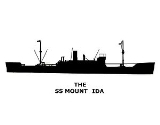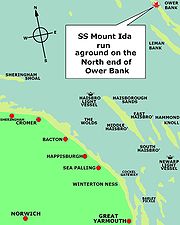
SS Mount Ida
Encyclopedia
The SS Mount Ida was a merchant ship built in 1938 by William Hamilton & Co. Ltd
William Hamilton and Company
William Hamilton and Company was a British shipyard located in Port Glasgow, Scotland. The company was purchased by Lithgow Ltd., later to become Scott Lithgow which was nationalised into British Shipbuilders in 1977....
of Glasgow
Glasgow
Glasgow is the largest city in Scotland and third most populous in the United Kingdom. The city is situated on the River Clyde in the country's west central lowlands...
. She had a three-cylinder triple-expansion engine which gave a service speed of around 10.5 knots (20.6 km/h). Originally called the Arcscott, she was renamed Mount Ida after being bought by the Atlanticos Steam Ship Company Ltd, of Athens
Athens
Athens , is the capital and largest city of Greece. Athens dominates the Attica region and is one of the world's oldest cities, as its recorded history spans around 3,400 years. Classical Athens was a powerful city-state...
, Greece
Greece
Greece , officially the Hellenic Republic , and historically Hellas or the Republic of Greece in English, is a country in southeastern Europe....
.
Last Voyage
In early October 1939 Mount Ida, carrying a cargo of grainGRAIN
GRAIN is a small international non-profit organisation that works to support small farmers and social movements in their struggles for community-controlled and biodiversity-based food systems. Our support takes the form of independent research and analysis, networking at local, regional and...
and timber
Timber
Timber may refer to:* Timber, a term common in the United Kingdom and Australia for wood materials * Timber, Oregon, an unincorporated community in the U.S...
, and with a crew of 29, left Vancouver
Vancouver
Vancouver is a coastal seaport city on the mainland of British Columbia, Canada. It is the hub of Greater Vancouver, which, with over 2.3 million residents, is the third most populous metropolitan area in the country,...
, Canada
Canada
Canada is a North American country consisting of ten provinces and three territories. Located in the northern part of the continent, it extends from the Atlantic Ocean in the east to the Pacific Ocean in the west, and northward into the Arctic Ocean...
, bound for the port of Leith
Leith
-South Leith v. North Leith:Up until the late 16th century Leith , comprised two separate towns on either side of the river....
, Scotland
Scotland
Scotland is a country that is part of the United Kingdom. Occupying the northern third of the island of Great Britain, it shares a border with England to the south and is bounded by the North Sea to the east, the Atlantic Ocean to the north and west, and the North Channel and Irish Sea to the...
. On 9 October she had reached the North Sea
North Sea
In the southwest, beyond the Straits of Dover, the North Sea becomes the English Channel connecting to the Atlantic Ocean. In the east, it connects to the Baltic Sea via the Skagerrak and Kattegat, narrow straits that separate Denmark from Norway and Sweden respectively...
and was close to the north -east coast of Norfolk
Norfolk
Norfolk is a low-lying county in the East of England. It has borders with Lincolnshire to the west, Cambridgeshire to the west and southwest and Suffolk to the south. Its northern and eastern boundaries are the North Sea coast and to the north-west the county is bordered by The Wash. The county...
. This is a particularly hazardous part of the North Sea, with many sand banks
Bar (landform)
A shoal, sandbar , or gravelbar is a somewhat linear landform within or extending into a body of water, typically composed of sand, silt or small pebbles. A spit or sandspit is a type of shoal...
, on one of which Mount Ida ran aground.
Cromer lifeboat to the rescue
The alarm was given at 6:25 am, when the coastguard informed the coxswainCoxswain
The coxswain is the person in charge of a boat, particularly its navigation and steering. The etymology of the word gives us a literal meaning of "boat servant" since it comes from cox, a coxboat or other small vessel kept aboard a ship, and swain, which can be rendered as boy, in authority. ...
of the Cromer
Cromer lifeboat station
Cromer Lifeboat Station is an RNLI station located in the town of Cromer in the English county of Norfolk. The station operates two lifeboats - one for inshore work and the other for offshore work....
lifeboat
Lifeboat (rescue)
A rescue lifeboat is a boat rescue craft which is used to attend a vessel in distress, or its survivors, to rescue crewmen and passengers. It can be hand pulled, sail powered or powered by an engine...
, Henry Blogg
Henry Blogg
Henry George Blogg GC BEM was a famous lifeboatman from Cromer on the north coast of Norfolk, England.Henry Blogg of Cromer is referred to as "the greatest of the lifeboatmen"...
, that the Mount Ida had run aground and asked that the lifeboat be sent to assist her. Since the outbreak of World War II, lifeboats of the RNLI
Royal National Lifeboat Institution
The Royal National Lifeboat Institution is a charity that saves lives at sea around the coasts of Great Britain, Ireland, the Channel Islands and the Isle of Man, as well as on selected inland waterways....
had been under the control of the naval authorities, and this was only the second rescue effort by the Cromer lifeboat under this arrangement.

Cromer
Cromer is a coastal town and civil parish in north Norfolk, England. The local government authority is North Norfolk District Council, whose headquarters is in Holt Road in the town. The town is situated 23 miles north of the county town, Norwich, and is 4 miles east of Sheringham...
lifeboat H F Bailey
Cromer Lifeboat H F Bailey III
H F Bailey III is the most famous Royal National Lifeboat Institution lifeboat to have served from Cromer, because she was used by Coxswain Henry Blogg to perform many of his most famous lifesaving exploits. The lifeboat was on station for the ten years between 1935 and 1945...
was launched and set off towards Haisborough Sands
Haisborough Sands
Haisborough Sands is a sandbank off the coast of Norfolk, England at Happisburgh. The shoal is long and wide and lies parallel to the North east coast of Norfolk. The shoal is marked to the north-west by north by the Haisbro Light Buoy, North cardinal...
, which is where Coxswain Blogg had been told the Mount Ida was aground. The lifeboat had been at sea for an hour when the coastguard informed Blogg by radio
Radio
Radio is the transmission of signals through free space by modulation of electromagnetic waves with frequencies below those of visible light. Electromagnetic radiation travels by means of oscillating electromagnetic fields that pass through the air and the vacuum of space...
that the Mount Ida was not on Haisborough Sands but was grounded 19 miles (30.6 km) further to the north-east, on Ower Bank.
The H F Bailey crossed Leman Bank and reached the Mount Ida around 12:30 pm. By this time the ship's starboard lifeboat
Lifeboat (shipboard)
A lifeboat is a small, rigid or inflatable watercraft carried for emergency evacuation in the event of a disaster aboard ship. In the military, a lifeboat may be referred to as a whaleboat, dinghy, or gig. The ship's tenders of cruise ships often double as lifeboats. Recreational sailors sometimes...
had been carried away, she was listing heavily to starboard and lying head on to the seas, and her position offered no lee
Windward and leeward
Windward is the direction upwind from the point of reference. Leeward is the direction downwind from the point of reference. The side of a ship that is towards the leeward is its lee side. If the vessel is heeling under the pressure of the wind, this will be the "lower side"...
for the lifeboat to come alongside. The H F Bailey made an attempt to throw a line to the stricken vessel but was twice struck by the heavy seas and flung back. Coxswain Blogg made another attempt to come alongside, before deciding that it was too dangerous and that he would have to wait for the sea to slacken.
By 2:15 pm conditions had improved and Blogg, using the lifeboat's powerful engines with great skill, was able to maintain a steady position alongside the ship for over an hour, during which time all 29 crewmen were brought off successfully, though one suffered crushed legs when he hesitated to descend the rope ladder and was trapped between the lifeboat and the Mount Ida; he later died of his injuries in Cromer Hospital
Cromer Hospital
Cromer and District Hospital opened in 1932 in the suburb of Suffield Park in the town of Cromer within the English county of Norfolk.. The hospital is run by the Norfolk and Norwich University Hospitals NHS Foundation Trust and provides an important range of acute consultant and nurse-led services...
.
During the rescue, the lifeboat was continually flung against the hull of the Mount Ida. Because the H F Bailey was badly damaged, Cromer’s no 2 lifeboat, Harriot Dixon, was called out to bring the rescued men ashore. The Harriot Dixon, too, was damaged as it was launched into heavy seas, but the rescue effort was successful.
The Mount Ida was never salvaged and slowly sank into the sands of Ower Bank. Her position was 53°10′44"N 1°55′46"E.

